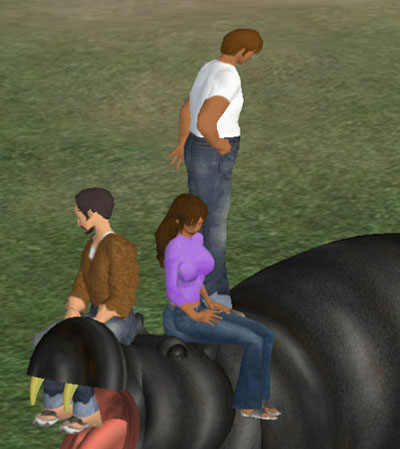Story witch doctor
Recently I’ve been working with a really smart researcher in computational linguistics and, as is happening with increasing frequency with my colleagues, he happened upon my blog. The Icelandic connection with my last name (Tolva = “number witch doctor” = computer) was particularly interesting to him. He writes:
You’re right about the aversion to foreign words in Icelandic. I observed that there. The Icelandic “tala” for “number” appears to be related to the words “tal” in Danish and “Zahl” in German for “number”. “Tala” may also be related to “tell” and “tale” in English, because these English words go back to an Indoeuropean word “del” that means “count” or “recount”. There seems to be a semantic etymological connection between telling (a story) and counting. German “zählen” means “count”, and “erzählen” means “tell”. Danish “tælle” is “count”, and “tale” is “speak”. In English we can “recount” a story or give an “account” of some event(s). Maybe the semantic connection is that as you’re telling a story, you’re counting off the events?
So not only is my surname the made-up word for computer, but it has etymological connections to storytelling. Computers and narrative. Counting and recounting. It’s all so clear to me now. I suppose I am doing what I was destined to do.
(Of course, I’m not Icelandic at all.)
Chinese Labor Day
You know that scene in Father of the Bride II where Steve Martin has the route to the hospital intricately plotted out in the event that his daughter (or was it wife) goes into labor? I laughed when I first saw that, pre-kids. Now it makes me laugh for a different reason, since that kind of detailed plan is bound to go awry. You’re almost asking for it to, taunting the due date gods to throw you a curveball. Short of scheduling an induction — and even that can be unpredictable — there’s really no way of knowing what is going to happen or, more specifically, when it will happen.
Which is why there’s palpable concern in my house over my departure today for China. With flights leaving for the US only during a certain window of time and the jaunt taking somewhere in the neighborhood of 14 hours, there’s almost no conceivable way I could make it back if my wife suddenly went into labor. Sure, this is highly unlikely. She’s neither dilated nor effaced. But then, our second son was three weeks early — and week 37 begins precisely as I am arriving home. So does the Chinese May Day week-long holiday.
Let’s hope China’s celebration of labor and mine happen half a world apart.
Over spilt milk
My almost-five-year-old son passed a real milestone this week. It wasn’t what you’d consider a typical development milestone. He laughed at himself. That’s all. But not at a stupid joke he told or at an act of preschooler physical comedy. He accidentally tripped over my feet with a full glass of milk and spilled it all over the floor, me, and himself. One look at him sodden with milk made me break out laughing. Usually this sort of thing makes him deeply embarrassed and he usually cries. But this time, despite a touch-and-go moment of upper lip quavering, he actually burst out laughing too. Laughing at himself, at his act. This is huge, I think. Being able to laugh at yourself is critical to self-awareness and coping with life.
Hell, if I couldn’t laugh at my own idiocy half my life would be spent weeping.
Corporate lingo watch
Ever since I first heard someone ask to “take this conversation offline” I’ve had a biochemical aversion to corporate parlance, especially when technical terms are used unironically to describe non-technical things. Today’s morsel went something like this:
“Thanks, Bob, I really like those ideas. One that I’d particularly like to double-click on was …”
Shouldn’t it be “click”? I mean, isn’t the implication here that this is an idea that should be followed, like one follows a link? Or is he double-clicking it to run it like an application? Start it up?
You know, if you’re going to lace discussions with technical metaphors that are already a minefield of business-specific terms you could at least strive not to sound like you’ve just discovered the mouse and GUI. Oooh, the pretty icons make my copy of WordPerfect come alive!
Two bitter posts in a row. Feels good.
Let’s hear it for the [child of unknown gender]
As my wife begins week 35 of her pregnancy with child #3 I have almost perfected the ability to guess the age and/or social upbringing of any person (typically a woman) who says “Oh, you have two boys? You must be trying for a girl.”
Trying for a girl? How about hoping not to have a child with Down’s Syndrome? Or hoping not to deliver a baby with the cord wrapped around its neck? How about getting a clue, people? I know that parents sometimes decide to have another child simply because they want a certain gender, but this is perverse. Unless you’re centrifuging semen, that’s a recipe for disappointment half the time.
Yet, you see this attitude in older people all the time. Have a girl? Oh, you must be trying for a boy. And it is of course worse when you’re having a third child. As if no one in their right minds would attempt three without striving for a specific gender. I really don’t get it. Oh and I am so looking forward to calling people (including family) from the hospital to announce our new son and receiving a dramatic pause and limp “Oh, wonderful. Will you try for a girl next time?”
Online calendars get serious

Last year I went through Outlook detox and successfully created cross-platform, web-synched versions of my mail and contacts. The calendar part was tougher, since there was no really good online app for the task. In the last couple of months this has changed. Kiko retooled, 30 Boxes launched, and Google Calendar cannonballed right into the pool.
I’ve spent some time really working with 30 Boxes and Google Calendar (Kiko, not so much). Google is the one to bet on, I think, because of their momentum in the space and track record. Also, as Web 2.0ish as 30 Boxes is I’ve come to agree with others that a duration view of events by day and week is crucial (and kinda pretty too) in that you can squint your eyes, find some white space, and simply know that you’re open during that period. The views on 30 Boxes are all list-based and make this kind of spatial reading of your calendar impossible. 30 Boxes does have the edge on integration of non-calendar data, though. You can pop in online web calendars, of course, but you can also read in any RSS feed imaginable. This is very useful for blog posts, weather, and anything else that makes sense to see in a calendar layout. Right now Google only does webcal, no RSS. (Anyone know of an online converter of an RSS feed to webcal?) Integrating specialized calendar feeds (such as those from Basecamp) is especially nice.
30 Boxes also has taken the tagging angle which allows you to filter and syndicate just about any slice of your calendar. Google only allows syndication of whole calendars. They’ll need finer granularity eventually. Google does repeating events and specifically modifications to repeating events much better than 30 Boxes. This becomes a huge deal when you want to skip or modify a particular instance of a repeating event. Obviously Google is well-integrated with GMail.
The glaring omission from all online calendars — and the reason they are not yet on par with mail and contacts — is synching. I can view my calendars in desktop apps (iCal and Sunbird) but I cannot modify them there for synching back to the server. You have to imagine that they are working on this, but from what I read the CalDAV spec is anything but ready for primetime. Also, the PC desktop apps that read iCal are godawful right now. That’s not Google’s or 30 Boxes problem, but it is a hindrance. MozCalendar/Sunbird is way behind Thunderbird and Firefox for sure.
Happy calendaring!
Misanthropomorphism
The elevators in our building have a curious recorded floor announcement. The female voice has an unplaceable accent: nasal, snooty-almost-schoolmarmish, vaguely Canadian. Probably the result of a focus group on pleasing intonation gone wrong.
I rode the elevator down today with a construction worker. We didn’t speak. As we emerged from the car I heard him mutter to himself “damn foreign elevators.” And he clomped off.
I’m really not sure he was kidding.
Converge this
If you’ve ever asked —
How does digital convergence transform the creative world of designers, developers, inventors, and entrepreneurs? How can we spot trends and practices that will prepare us for the future in a world of accelerating change?
— perhaps you should get Googling. Chances are, the panel I was on at SxSW will leave you more confused than enlightened*. But if you must know, the podcast of the panel is now available.
[*] Through no fault of my co-panelists I hasten to add.
Z
Got a new laptop, the Thinkpad Z60m. It is one of the first Thinkpads since Lenovo took over PC operations from IBM and you can definitely see the new direction (though one wonders if this was already in the planning pipeline in IBM before the sale): widescreen aspect ratio, Firewire, no parallel port (welcome to the late 1990’s!), media card reader, fingerprint reader. The screen is brilliant, so much so that the dragged-window transition to my second (external, old) monitor actually hurts my eyes. And the video card is a dream. The battery’s nice too. One unexpected problem is that Lenovo switched the nearly decade-old power coupling so my half-dozen AC units are utterly useless. I like the fingerprint reader, but its utility seems so far short of what it could do if it integrated with saved passwords in Firefox., etc. Logging on with your finger is fine, but how about addressing the awfulness that is system-wide user authentication?
Oh, it also has a titanium cover which makes it look at least different from most Thinkpads (and somewhat striking), but one wonders if that’s just a symptom of Powerbook envy. Truth to be told, with the new dual-boot Intel MacBooks and IBM no longer producing PC’s the issue may be moot. Maybe my next work laptop will be Mac. There is already a supported suite of internal applications for the Mac. One can dream.
Two worlds come to life

This past Sunday Chicagoans emerged from their winter bunkers to embrace the first Spring-like weather we’ve had. They did it enthusiastically. Perhaps too much so: it really wasn’t that warm. But goodness what a difference it made. The city was seething with happiness. Everyone was outside, walking, running, playing, being seen, having brunch with friends, perched on stoops, meeting neighbors. If the city is a living organism and sidewalks are the circulatory system then this specimen was near the peak of its cardiovasicular capacity.
I have said it before and I will say it again: there is no city on Earth that does summer as well as Chicago does. The most deliberately savored 90 days anywhere. This past weekend was but a warmup.
Another world came alive this weekend, to me at least. I’ve mentioned my interest in the virtual world known as Second Life. Now, you’re probably thinking, this guy has two kids with a third on the way — of course he needs a second life. Har. Actually I find it fascinating, like I’ve just discovered the web or something (which I remember vividly, thank you Mosaic!) Some colleagues of mine in the UK actually use Second Life for team meetings, an idea that makes a ton of sense since it merges the textual immediacy of chat with the gestural and multimedia capacity of videoconferencing.
My sister and father and I have a bookclub. We rotate selection of the book and it gives us a great excuse to to take a break from our own families and have a lunch together. We usually select a place to eat that has some relationship to the book. (For instance, for one of my Dad’s selections about the Manhattan Project we met near the site of the first successful fission of an atom at the University of Chicago.) The book we read this time was Cast of Shadows, a story about a doctor working at a human cloning clinic (like a reproduction clinic) whose daughter is raped and killed and whose murderer is never caught. The doctor, using semen from the crime scene, clones his daughter’s killer and arranges for him to be raised by a couple out of fertility options. He follows the boy as he grows in hopes of getting a clue to the man — the boy’s genetic clone, of course — who killed his daughter. A significant portion of the book occurs in a virtual environment called Shadow World, furthering the notion of cloning. Well, Second Life is a lot like Shadow World. So we had our bookclub in there, virtually, as avatars in Second Life.
What made this experiment more interesting is that my dad, sis, and I were all physically together in my basement on different computers interacting more or less interchangeably inside and outside of the world. Once we got past the normal new-user issues with my father (forgotten password, all thumbs on the keyboard, etc.) we were off and running — or flying, the mode of transport most useful in SL. It was probably the most enjoyable bookclub we’ve had. I was the tour guide, showing my family around my favorite parts of Second Life like a museum docent. Most of the club meeting was spent looking for somewhere out of earshot of others where we could quietly discuss the book. This was probably a mistake since all we’d really have to do is IM each other in-world, but I found it interesting that we desperately wanted to find some real-world analog (like a coffee shop) to have our conversation.
My father, true to real life, kept getting lost. Luckily I could always offer to teleport him to where my sister and I were. If only we had this ability in real life. Body modification also occupied much of my father’s and sister’s time. My sister — a petite, conservative lawyer in real life — was obsessed with being, well, slutty. She gave herself the biggest boobs allowable, pants that literally were painted on, and lips that were comically oversized. I could hardly look at her for fear of the disturbing possibility of being turned on by a virtual depiction of my own sister. My father, on the other hand, looked like a lifelong beer drinker who focused exclusively on upper-chest muscle toning. We were a motley crew. My sister was deathly afraid of interaction with the other residents of Second Life. (Well, she should have been, dressed like that!) In her mind she had a specific reason for being in SL whereas all these other people were clearly miscreant do-nothings simply prowling about. (This is definitely not the case. In fact it is probably the opposite right now, akin to the early days of the Internet when it was populated only with a certain intelligent stratum of tech-savvy adventurers. Give it time, though. I predict we’ll see the same diversified spamification of Second Life as we’ve seen in e-mail and on the web.)
The session ended, rather poetically, with us all astride a statue of a hippopotamus in a park we stumbled into somewhere. That’s the beauty of SL. Like a second box of chocolates, you still never know what you’re going to get.













